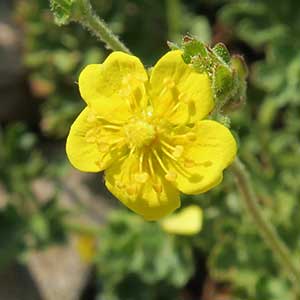Potentilla bipinnatifida
Potentilla brevifolia
bipinnate cinquefoil, potentille bipinnatifide, tansy cinquefoil
short-leaf cinquefoil, sparse-leaf cinquefoil
ascending to erect, (1–)2–5 dm.
subpinnate to subpalmate, (6–)10–25 cm;
petiole (2–)5–15 cm, long hairs dense, appressed, 1–2 mm, soft to ± stiff, short hairs absent, crisped hairs sparse, glands absent, sparse, or obscured;
leaflets 2–3 per side, on distal 1/6–1/3(–1/2) of leaf axis, separate to ± overlapping, terminal ones oblanceolate, (2–)3–6(–10) × 1–2(–3.5) cm, margins revolute, incised 3/4+ to midvein, undivided medial blade 1.5–6 mm wide, teeth 5–8 per side, ± linear, surfaces ± to strongly dissimilar, abaxial usually white, rarely grayish, long hairs abundant especially on veins, 1–2 mm, ± weak, short hairs absent or obscured, cottony (and crisped) hairs ± dense, glands absent or obscured, adaxial green to grayish, long hairs sparse to abundant, loosely appressed, 0.5–1.5 mm, short hairs absent or sparse, crisped and/or cottony hairs sparse to common, glands sparse to common.
petiole 1–4 cm, eglandular hairs absent or sparse, spreading, less than 1 mm, weak, glands abundant.
2–4.
(4–)10–50(–100)-flowered, congested or elongating in fruit.
0.2–0.8 cm (proximal to 2 cm).
epicalyx bractlets narrowly elliptic to lanceolate, 2.5–6 mm, lengths ± 2/3 times sepals, margins flat;
hypanthium 3–5 mm diam.;
sepals 3–6 mm, apex ± acute, abaxial surfaces: venation indistinct, glands absent, sparse, or obscured;
petals yellow, 3–5 × 3–4 mm, lengths ± equal to sepals;
filaments 0.5–2 mm, anthers 0.3–0.5 mm;
carpels 50–80, styles papillate-swollen in proximal 1/2–3/4+, 1–1.2 mm.
epicalyx bractlets lanceolate-elliptic to ovate, 2–4 × 0.8–2 mm;
sepals 3–5(–7) mm, apex broadly acute to obtuse;
petals 3.5–6.5 × 3–5 mm;
filaments 1–2.5 mm, anthers 0.5–0.6 mm;
carpels 10–15.
1–1.2 mm, smooth to faintly rugose.
1–1.5 mm.
= 56.
Potentilla bipinnatifida
Potentilla brevifolia
Potentilla bipinnatifida is similar to P. litoralis in habit and leaf dissection but has flat, silky epicalyx bractlets and sepals with no evident glands. Vestiture is generally silkier, and the silvery to bicolor leaves are white-cottony abaxially. The two species are sympatric in the plains of Canada, with some intergradation; P. bipinnatifida is also common south to Colorado, where it is found in intermontane meadows and sagebrush flats. Outlying populations occur in Blaine and Custer counties, Idaho, and Duchesne and Piute counties, Utah. Eastern collections from disturbed sites might be adventive.
Potentilla missourica Hornemann ex Lindley and P. normalis Besser ex Sprengel are older names for this species; both were rejected against a conserved P. bipinnatifida with designated lectotypes (see J. Soják 2008b).
(Discussion copyrighted by Flora of North America; reprinted with permission.)
Potentilla brevifolia is found mainly in alpine situations in the Pioneer, Sawtooth, Smoky, and White Cloud mountains of central Idaho; the Madison Range of western Montana; the Jarbidge Range of northeastern Nevada; the Blue, Steens, and Wallowa mountains of eastern Oregon; and the Teton Range of northwestern Wyoming. The elongate caudices are easily covered by moving soil and talus.
(Discussion copyrighted by Flora of North America; reprinted with permission.)


